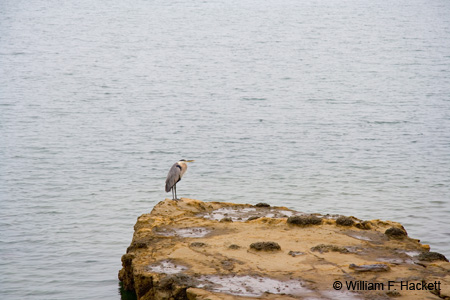Great Blue Heron

The Great Blue Heron, Ardea herodias (1, 2), is common over most of North and Central America, the West Indies, and the Galápagos Islands. In addition, the bird is a very rare visitor (“vagrant”) to Europe, with reports of the bird “dropping in” to England, Spain, and the Azores. Great Blue Herons are wading birds of the heron family Ardeidae and the largest American heron. The head-to-tail length is 36-54 inches (91-137 cm), and the wingspan can be 71 inches (180 cm). The bird can weigh 4.8-8 pounds (2.2-3.6 kg).
Great Blue Herons always live near sources of water, including rivers, lake shores, marshes, saltwater seacoasts (the photo above was taken on the coast at Princeton-by-the-Sea), and swamps. The birds usually nest in trees or bushes near water. On the East Coast, the birds tend to avoid marine habitats and live inland, instead. This Great Blue Heron was photographed at Jewel Lake in Tilden Park.
There are five subspecies of Great Blue Heron, including:
- Ardea herodias herodias Linnaeus, 1758 – most of North America
- Ardea herodias fannini Chapman, 1901 – the Pacific Northwest from southern Alaska to Washington; coastal
- Ardea herodias wardi Ridgway, 1882 – Kansas and Oklahoma to northern Florida
- Ardea herodias occidentalis Audobon, 1835 – southern Florida and Caribbean islands
- Ardea herodias cognata Bangs, 1903 – Galápagos Islands
There is also a white morph of the subspecies occidentalis, which is called the Great White Heron and was once thought to be a separate species.
The main food for the Great Blue Heron is small fish, although they will also eat shellfish, insects, reptiles, amphibians, rodents and small birds. The Great Blue Heron is a solitary feeder and usually forages while standing in water. The bird will also forage in fields or drop from the air or a perch into water.
Groups of Great Blue Heron will nest together in colonies, with 5-500 nests/colony and an average of 160 nests/colony. The nests are bulky and made of sticks. Each nest harbors 3-6 pale blue eggs, which incubate for about 28 days.
Great Blue Heron in colder climates east of the Rocky Mountains migrate to Central and South America in the winter. In the southern states and on the Pacific Coast, the birds are residents year round.
-Bill at Cheshire Cat Photo™
You can view higher-resolution photos (*generally* 7-30 megabytes, compressed) at the Cheshire Cat Photo™ Pro Gallery on Shutterfly™, where you can also order prints and gifts decorated with the photos of your choice from the gallery. Apparel and other gifts decorated with some of our most popular photos can be ordered from the Cheshire Cat Photo™ Store on CafePress®. Both Shutterfly™ and CafePress® ship to most international locations worldwide!







